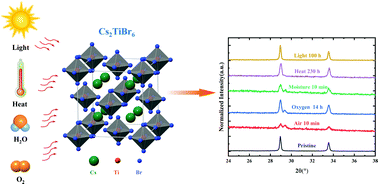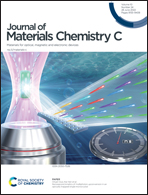Stability investigation of the titanium-based eco-friendly perovskite-like antifluorite Cs2TiBr6†
Abstract
Cs2TiBr6 has been proposed as a nontoxic, earth-abundant material. Theoretical analysis has shown that it exhibits excellent stability and photoelectric properties, providing great potential for photovoltaic (PV) applications. However, recent experiments showed controversial results on Cs2TiBr6 stability. Some claimed that Cs2TiBr6 is stable in air, while the others had the opposite result. In this work, we synthesize the Cs2TiBr6 powder by a full aqueous solution process and demonstrate that it is highly unstable in air. To reveal the decomposition mechanism, we conduct individual investigations on its oxygen, moisture, thermal, and light stability. It is found that the Cs2TiBr6 powder is highly unstable in individual oxygen and moisture environments, while it is very stable under light illumination conditions. It is noted that the Cs2TiBr6 powder decomposes into amorphous TiO2 in both individual oxygen and moisture environments, and it is accompanied by the decomposition product of (H2O)0.25·Ti4O7(OH)2 under moisture conditions. Regarding the thermal stability, the Cs2TiBr6 powder is unstable at 200 °C, but stable at 100 °C. Furthermore, the thermal and light stability of the Cs2TiBr6 film has also been verified. Our work shows that the Cs2TiBr6 film has the potential for application in detectors, solar cells, and other devices if well encapsulated.



 Please wait while we load your content...
Please wait while we load your content...